Meet the 2023 NMR RABDF Gold Cup finalists
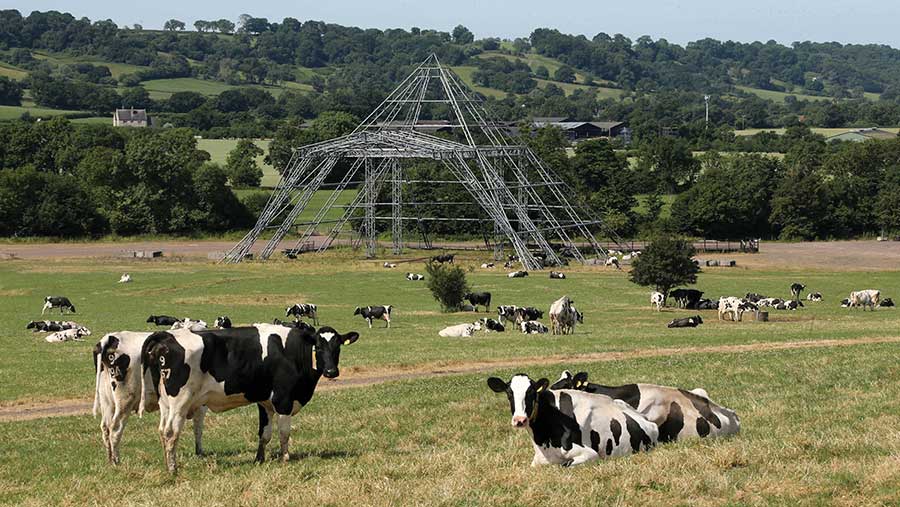 Worth Farm cows © RABDF
Worth Farm cows © RABDF Four herds farming sustainably, using technology and focusing on staff management are competing for the 2023 Gold Cup award, sponsored by the Royal Association of British Dairy Farmers (RABDF) and National Milk Records (NMR).
This year’s judges are RABDF chairman and Cumbrian dairy farmer, Robert Craig, immediate past chairman and Devon dairy farmer, Di Wastenage, NMR’s veterinary adviser, Dr Karen Bond, and 2020 Gold Cup winner Essex dairy farmer, John Torrance.
The winner will be named at Dairy-Tech on 7 February.
See also: Meet the 2022 NMR Gold Cup finalists
The four finalists are:
Hallam Mills and George Brown
Bisterne Farms, Sandford, Ringwood, Hampshire
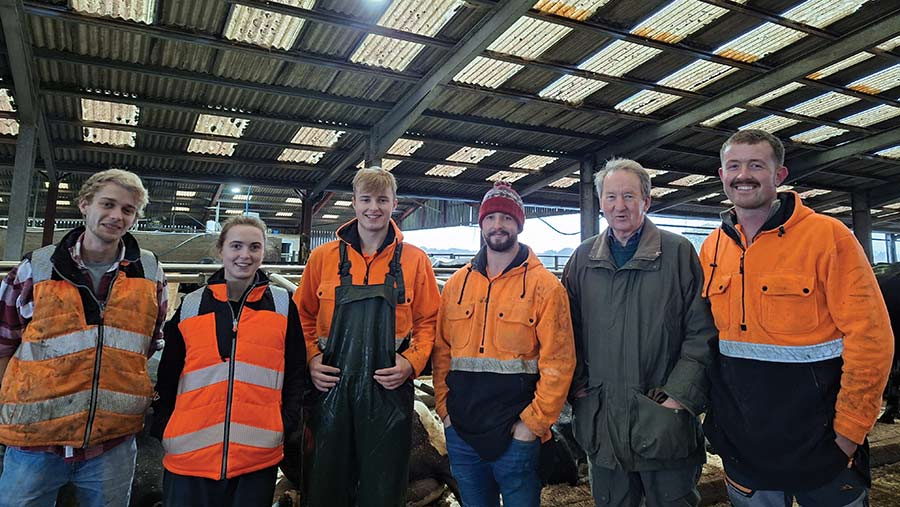
James Dunning, Charlotte Lawder, Adam Reddish, Oli Mears, Hallam Mills and George Brown © RABDF
A joint venture begun in 2019 is combining strong grazing principles with a drive to reduce its carbon footprint. Focused on improving efficiency and profitability, the contract farming agreement between Hallam Mills and George Brown, is designed to encourage new entrants into the dairy industry.
Hallam provides land, buildings, houses, and fixed infrastructure, while George provides machinery, power and labour to the enterprise.
Cows yield 550kg of milk solids a cow, and produce 3,730 litres from forage, targeting 4,000 litres. Breeding is based on New Zealand Friesian sires for a robust grazing cow.
The herd was originally spring-block calving and outwintered on fodder beet. But free-draining soils meant summer grazing dried up. Cows have now transitioned to a split block, with 70% calving in autumn, and 30% in spring.
The autumn block is housed in cubicles on a self-feed system of grass and maize silages.
Moving to soya-free diets reduced the carbon footprint to 1.09kg carbon dioxide equivalent/kg FCPM, excluding sequestration. Clover and herbs are included in swards to reduce nitrogen inputs, making use of the support available under Higher Level Stewardship and the Sustainable Farming Incentive.
The farm team comprises five full-time staff and three students – the majority from non-farming backgrounds – and the partners are committed to training the next generation of farmers.
Farm facts: Bisterne Farms
- Milking 600 cross-bred cows
- Average production 6,282 litres at 5.06 % butterfat and 3.84% protein
- Split-block calving
- Grazing from 4 February to 21 December
- Somatic cell count of 162,000 cells/ml
- Mastitis rate at 22.6%
- Estate of 1,500 ha
- 190ha grazing platform
- 319ha of silage and youngstock ground
- Supplies Arla
Michael Eavis
Worthy Farm, Shepton Mallet, Somerset
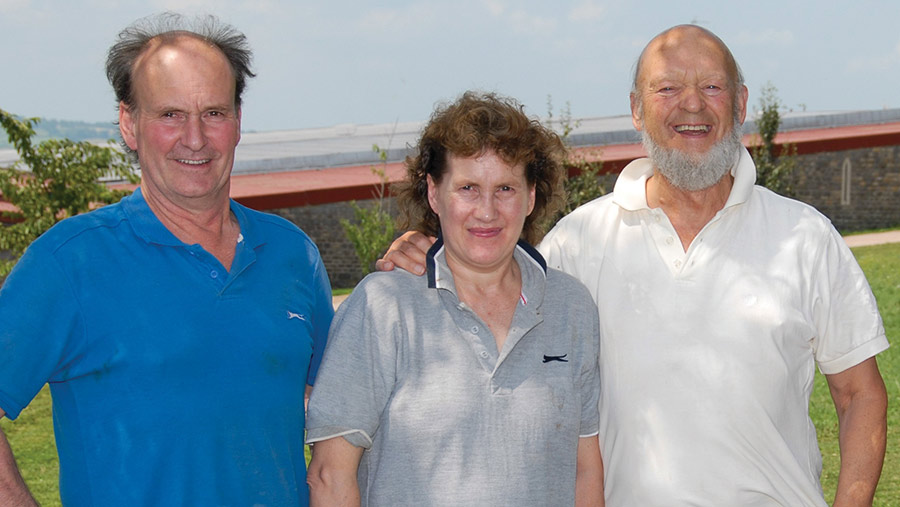
John and Pam Taylor with Michael Eavis (right) © RABDF
A previous Gold Cup winner (2014), and home to the Glastonbury music festival, Worthy Farm has taken advantage of its place in the spotlight to tell the public about agriculture.
The old milking parlour has been replaced by a robotic rotary and remodelled into an education facility. The business has also diversified its brand into making cheese.
Although Michael Eavis is still heavily involved, the herd is managed by long-term staff John and Pam Taylor, supported by five dairy staff.
To improve sustainability, the farm has invested in an anaerobic digester with long-term ambitions to dry slurry to a prilled, exportable fertiliser, and use new technology to create a renewable vehicle fuel.
Taking the farm off grid, solar panels now power the parlour, with rainwater harvesting and filtration used to keep the panels clean, as well as provide farm drinking water.
Focusing on a high health status, Johne’s screening is carried out quarterly and the team has worked hard to reduce the use of injectable antibiotics for mastitis. Current antibiotics usage sits at 32.8mg/PCU.
Staff are encouraged to report any lameness, with all cows mobility scored daily. Cows scoring above a 0 are segregated from the herd, treated within 48 hours, given pain relief, and allowed to rest in a loose straw yard.
Farm facts: Worthy Farm
- Milking 500 Holsteins
- Farming 394ha
- Average production 12,000 litres at 4.06% fat and 3.42% protein
- All-year-round calving
- Grazing 100 days a year
- Somatic cell count: 178,000cells/ml
- Supplies Wyke Farms
- 33% of milk turned into Worthy Reserve Chedder
- Routine Johne’s screening
- 5.2% mortality from birth to first calving
William, Jason and Stuart Graham
Graham Farms, Drumgoon Manor, Maguiresbridge, Co. Fermanagh, Northern Ireland
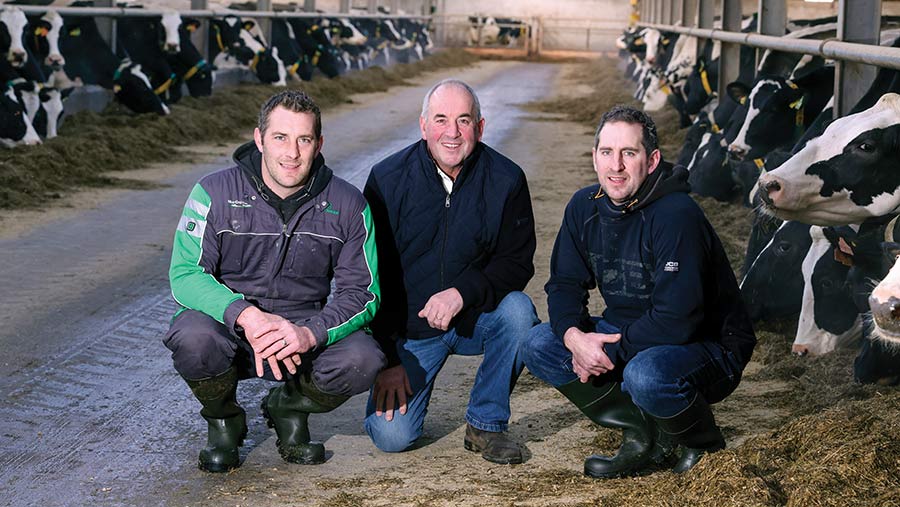
Stuart, William and Jason Graham © RABDF
Attention to detail across their dairy business has seen the Graham family, from Northern Ireland, shortlisted this year. William’s goal is to make a financially strong business to allow for succession.
He works alongside his sons Jason, a vet, and Stuart, an engineer. Jason is responsible for all herd health and breeding, and his focus has reduced antibiotics levels to 21.8 mg/PCU with a herd calving index of 369 days.
Stuart brought his building, business and people skills back to the farm – designing and building housing to promote cow and calf comfort.
He looks after the farm’s five full-time staff (plus part-time milkers and seasonal workers) and supply acquisition.
The family aim to maintain farm output while addressing environmental issues.
The farm’s carbon footprint is 1.3976/kg fat- and protein-corrected milk (FCPM). A push to increase milk from forage, by adopting a multicut silage system, is supported by a new store for straights to help drive down feed costs and reduce the carbon footprint by buying full loads.
Clover has been introduced to grass swards for extra protein and its nitrogen-fixing ability.
Growing more grass/ha from less purchased nitrogen also includes treating slurry with additives to help increase its available nitrogen.
A proportion of hedgerows are left untrimmed and lakeside woodland managed to improve biodiversity.
Farm facts: Graham Farms
- Milking 600 pedigree Holsteins
- Average production 11,400 litres at 4.1% fat and 3.29% protein
- All-year-round calving
- 6% mortality from birth to first calving
- Mastitis rate: 22.6%
- Lameness rate: 5%
- Somatic cell count: 76,000 cells/ml
- Overall pregnancy rate: 41.4%,
- Farming 351ha
- Supplies Glanbia
Joe Ives
W&P Ives, Herriard, Basingstoke, Hampshire
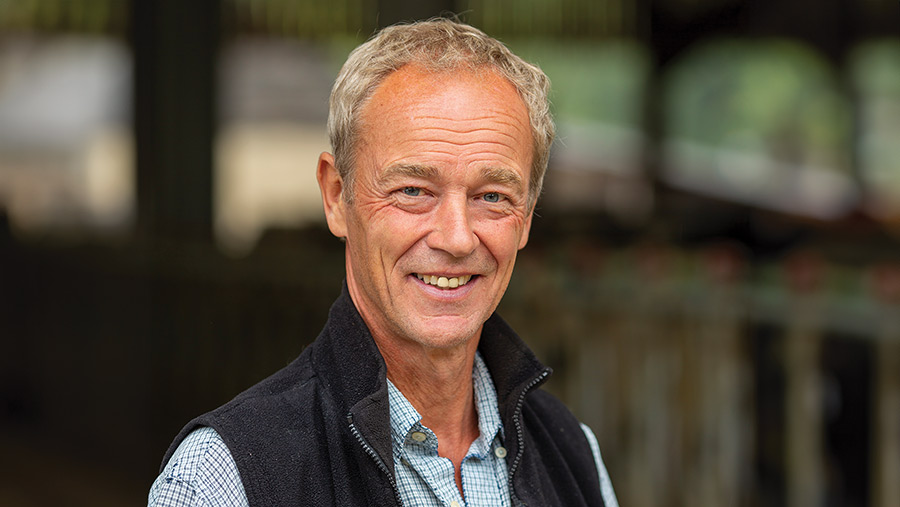
Joe Ives © RABDF
Joe and Claire Ives’ dairy farm business was a finalist in 2020 and winner of the Chris May Memorial Cup in 2019.
This time they showcase improved infrastructure to future-proof their business with new technology to support good stockmanship. These developments also ensure they produce top-quality milk in a sustainable way.
Cow data and milk records remain fundamental to herd improvements.
A far-off dry cow building has been added, plus a serving barn for heifers with locking yokes to allow for more efficient insemination.
Genomic testing of heifers for the past five years helps in selecting animals to breed efficient, long-life replacements from using sexed semen. Surplus heifers are sold.
Herd health screens for Johne’s, bovine viral diarrhoea (BVD), infectious bovine rhinotracheitis (IBR) and leptospirosis. Cows are monitored electronically through the robots.
The cows are mobility scored monthly, with an independent scorer once a year. Foot trimming is done in-house to be on top of any problems straight away and routine trims are at 1,000 days in milk plus drying off.
Technology helps monitor body condition with weights recorded at every milking. The nutritionist and vet will investigate any worrying trends.
Selective dry cow therapy is used on 75% of cows. Non-critical antibiotics usage in this herd is currently 4.95mg/PCU.
Farm facts: Park Farm
- Milking 250 pedigree Holsteins
- Average production 13,700 litres at 3.91 % fat and 3.19 % protein
- Dairy unit farms 160ha of the 206ha tenancy
- All-year-round calving
- Milked through 4 robots
- Calving interval: 385 days
- Conception rate: 42% for milking animals
- Mastitis rate: 9.4%
- Lameness – 96% of herd mobility score 0 or 1
- Herd replacement rate: 25%
- Supplies Arla
